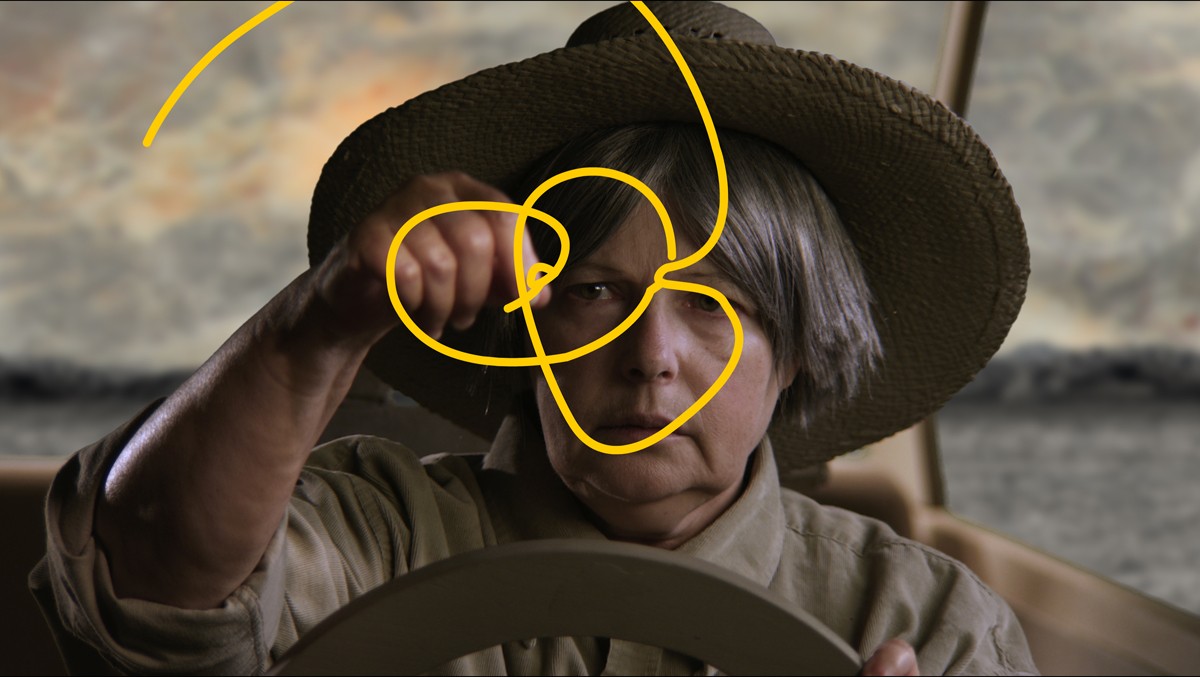
We are a malleable people. We adjust the face we present to the world, change our mind or take our life in a different direction whenever we're dissatisfied, but it's always a zero-sum situation. Change requires introspection and alone time, as well as the potential loss of those around us who are unwilling to support the new individual that arrives from that awareness. The Play-Doh Effect—add a little red or a little blue, and suddenly we're purple—and its lonely road is just one of the themes of multimedia artist Brian Bress' one man show, curated by Whitney Tassie and Nora Burnett Abrams, at Orange County Museum of Art. Even its title, “Make Your Own Friends,” references an inventive solitude.
In the 2014 video Organizing the Physical Evidence (Purple), two block-headed figures shift ovoid shapes around on their blank canvas faces. The costumes have no eye holes, so they're doing this blind, their arrangement and rearrangement a Dali/Picasso mashup. As Bress superimposes more hands in a Kaliesque effect, the video retains its mood of slow, constant chaos until the two figures wipe each other's face clean . . . but then the loop begins again. Rock Cowboy, a monologue from a pile of rocks wearing a Stetson, urges audiences to be empathetic, imagining what life would be like as a kitsch household item. Being Bamboo's costumed narrator breaks down the different ways the wood can be utilized, implying that what appears as one thing can easily become something else.
The elderly female protagonist in Creatives Ideas for Every Season drives through a desolate green-screen landscape, having an existential crisis, as her passengers change every few minutes. Bress makes an appearance as a buck-toothed car mechanic popping up out of her dashboard who proceeds to read her an ineffectual repair manual and give tips on holiday displays, but the ensuing babble/conversation indicates that despite the help, she's still on her own. In Status Report, a boxer punches at a vaginal Rorschach inkblot, Tom Cruise's Lestat from Interview With a Vampire asks people to have his baby, a coal miner discusses the difference between a job and a hobby, and an astronaut cruises through space, ending the video singing the chorus of Elvis Costello's “Radio Silence.”
Not much of this makes sense—and it's too long—but Bress' attempts to make painted environments come alive while reinterpreting vaguely familiar movie images into performance art is intriguing. I just wish he didn't act in his own pieces because his fall-back on walking speech impediments as characterization indicates he's a better director than he is a performer.
Bress' video paintings work the best: There's no overt narrative, just framed monitors with the art playing within. Ridley-Tree Sleeper # 1 (Nick and Brian) is Cubism brought to life. As with those moments in Pageant of the Masters in which the performers slot into position to create art masterpieces in full view of the audience, the mask shifts and tilts, stretching an arm or cupping a chin pensively, smashing the boundaries between painting and performance art, while losing neither medium's magic. Also dazzling is 370 Cover, as sections are cut out from behind a grid of parallel and vertical black-and-white lines slyly referencing Sol LeWitt's Wall Drawing #370. Once a large enough space is carved out, a geometric mask tries to poke through, but it's generally a different shape than the area cut out, continuing the idea of an isolated outsider attempting to break through, but still unable to fit in.
Puppets on display are almost never as interesting as when they're occupied by the puppeteer, so Bress' costumes by themselves don't have the same level of personality as when we see them in action. It's easy to admire the build on his Cousin It/Yeti hybrid Whitewalker (costume), a suit made of bamboo beads on wire, Polyurethane foam, latex and leather, but when it's filmed walking toward the camera in slow motion (Whitewalker #1), each bead vibrates, sways, twirls and flips in a mesmerizing wave. Beadman (costume), its multicolored wooden pellets loosely stitched to a bodysuit of some of the same materials as Whitewalker (costume), gets an approving glance, and then a move on to the next exhibit, but everything changes watching a performer jumping up and down while wearing it [Beadman (Parker)], the beads coming loose, bouncing or rolling around the floor as they lift into the air and land, an anti-inertia study in motion.
While Bress' ADHD attempt at philosophical discussion can wear thin at times, the questions he asks and ideas he broaches, however sloppy, are hardly cookie-cutter. There's no closing salvo to send you off as you exit; it's just the onslaught of his images floating in your head as you try to sort through them. You're alone, left to your own devices to make sense of the senseless—but you're used to that, right?
“Brian Bress: Make Your Own Friends” at Orange County Museum of Art, 850 San Clemente Dr., Newport Beach, (949) 759-1122; ocma.net. Open Wed.- Thurs. & Sat.-Sun., 11 a.m.-5 p.m.; Fri., 11 a.m.-8 p.m. Through Dec. 4. $7.50-$10; children younger than 12, free; Fri., free.
Dave Barton has written for the OC Weekly for over twenty years, the last eight as their lead art critic. He has interviewed artists from punk rock photographer Edward Colver to monologist Mike Daisey, playwright Joe Penhall to culture jammer Ron English.

